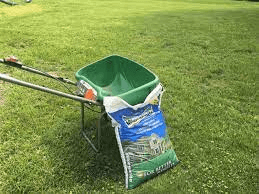Table of Contents

Many gardeners think that a perfect lawn is always a vibrant shade of green and is completely free of pests and illnesses. You can’t obtain an ideal lawn if you don’t invest time and effort and for this purpose fertilization is inevitable.
It sustains a healthy property, which can better resist pests and illnesses and compete with weeds. Now, many people may tire of the procedure of regularly adding N, P, and K fertilizers. That’s why Milorganite Fertilizer become a hot commodity among people for the best lawn care.
This article will help you to understand the information about Milorganite, its importance, and uses, methods of application, and when to apply Milorganite to your lawn for best results.
What is Milorganite?
Milorganite is a slow-release nitrogen fertilizer that comes from natural sources. It’s a byproduct of the treatment of sewage in Milwaukee, WI. When the microbes have finished digesting the organic matter, it is processed, kiln-dried, and packaged as Milorganite.

NPK testing reveals that Milorganite has a value of 6-4-0. This indicates that each bag contains just over 6% nitrogen (N), 4% phosphorus (P), and less than 1% potassium. Clients rely on the 2.5% non-staining iron in milorganite to achieve the healthiest, most vibrant green on their lawns. Learn more about each nutrient’s role in promoting plant health below. Because of the low concentrations of the micronutrients in Milorganite, they are not included in the nutritional breakdown on the bag.
How often during the year should Milorganite be applied?
It would help if you usually fertilize four times a year. However, if you want to fertilize your lawn once a year, the best time is in the early fall. This will give your grass a good start on recovering from the winter.
Now, let’s dive into when to apply Milorganite in your lawn, depending on your geographic location and lawn type.
To use Milorganite on cool-season grasses
- These types of grass are typically found in northern climates. They are annual and perennial ryegrass, creeping bentgrass, and Kentucky bluegrass.
- In early to mid-May, after the last frost and when the grass has begun to grow, apply milorganite. This is when the daily highs have been consistently around 60 degrees. It would help if you used the initial dose now for maximum effectiveness. Because of this, the plant will be more likely to put its energy into developing solid roots rather than just producing a tall, thin stem.
- The second time around, do it in early July while the grass is still actively growing. Time the third application for early September, and leave the final application until as late in the season as feasible, preferably the middle of November, right before the hard freeze.

To use milorganite for warm-season grasses
- Applying milorganite to warm-season grasses is not recommended in the late fall. Still, cool-season grasses need to have fertilizer before the heavy freeze begins. Doing so promotes lusher grass growth come spring.
- Your application will have a better chance of being noticed if you submit it over the winter or summer breaks. This simplifies monitoring and gives you plenty of time to spread milorganite. St. Augustine grass, centipede grass, and Bermuda grass are common types of grass produced in the South.
- The optimal time of year to apply milorganite to warm-season grass is between the middle and end of March. When the grass is just turning green in the spring, when the temperature has stabilized around 70 degrees (ideally), apply the fertilizer.
- It would be best if you reapplied this milorganite in the middle to the end of May when the grass is still actively growing. Its continued rapid development requires a substantial amount of food and other nutrients at this stage.
- August or early September is the time for the third application of milorganite fertilizer, and early October is the time for the fourth. Avoid applying milorganite in the late fall because that’s when the grass is getting ready to become dormant.

Guidelines for Milorganite Lawn Treatment:
- You should mow your grass before applying Milorganite to improve soil contact. It is advisable to use half the amount of Milorganite in one direction and the other half in the other direction.
- To aid in a uniform application, Milorganite includes a recommended spreader list and recommended settings. Even if your spreader isn’t on the list, you can use these simple steps to get it calibrated. This is a once-and-done task.
- Increasing or decreasing your application rate depends on your pace. While you’re out there fertilizing, keep a steady pace. The more quickly you walk, the less Milorganite you spread.
- The release of nutrients into your grass will be sped up by watering or rain, although milorganite does not require watering like synthetically created fertilizers. Fertilizing should be done in the fall if at all possible.
Required Equipment and Supplies
You’ll need
- Milorganite
- A lawn spreader (drop or broadcast spreader)
- An aerator application
Procedure:
- Watering the soil 2–3 days before the application will maintain the ground moist but still allow the grass blades to dry out. Aeration is further aided by watering the area to be treated before application.
- To facilitate the migration of the milorganite, aeration is crucial. This helps the fertilizer penetrate the soil faster and breaks up hard-pan areas.
- Place the spreader on a flat surface and pour milorganite into the hopper. It would help if you sealed off the hopper’s openings to prevent any from spilling onto the driveway.
- Spread the milorganite by starting at one end of the grass with the spreader, opening the vents, and walking quickly across the lawn to create a strip. Continue until the entire property has been coated.
Wrap Up
This article presented the importance of milorganite as a fertilizer to achieve thick, green grass. You must take a chance with Milorganite if you want a silver bullet that will make your lawn envy the neighborhood. It will nourish your lawn and make your yard greener without damaging it. To feed your lawn with this organic, long-lasting product, you now have all the knowledge you need to know about when to apply Milorganite in your lawn, one of my favorite lawn fertilizers.
